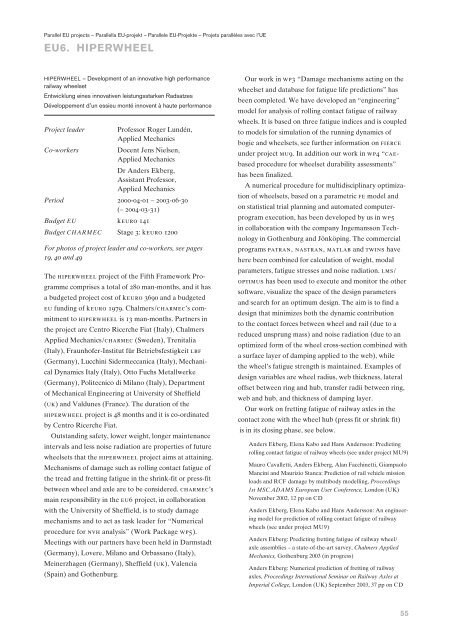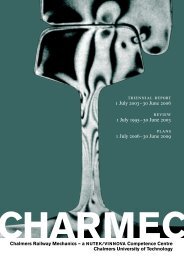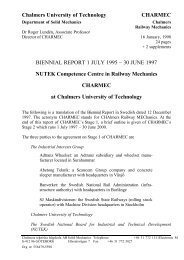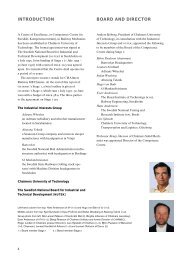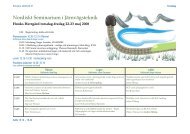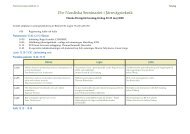You also want an ePaper? Increase the reach of your titles
YUMPU automatically turns print PDFs into web optimized ePapers that Google loves.
Parallel EU projects – Parallella EU-projekt – Parallele EU-Projekte – Projets parallèles avec l’UEEU6. HIPERWHEELHIPERWHEEL – Development of an innovative high performancerailway wheelsetEntwicklung eines innovativen leistungsstarken RadsatzesDéveloppement d’un essieu monté innovent à haute performanceProject leaderProfessor Roger Lundén,Applied MechanicsCo-workersDocent Jens Nielsen,Applied MechanicsDr Anders Ekberg,Assistant Professor,Applied MechanicsPeriod 2000-04-01 – <strong>2003</strong>-06-30(– 2004-03-31)Budget EU keuro 141Budget <strong>CHARMEC</strong> Stage 3: keuro 1200For photos of project leader and co-workers, see pages19, 40 and 49The hiperwheel project of the Fifth Framework Programmecomprises a total of 280 man-months, and it hasa budgeted project cost of keuro 3690 and a budgetedeu funding of keuro 1979. Chalmers/charmec’s commitmentto hiperwheel is 13 man-months. Partners inthe project are Centro Ricerche Fiat (Italy), ChalmersApplied Mechanics/charmec (Sweden), Trenitalia(Italy), Fraunhofer-Institut für Betriebsfestigkeit lbf(Germany), Lucchini Sidermeccanica (Italy), MechanicalDynamics Italy (Italy), Otto Fuchs Metallwerke(Germany), Politecnico di Milano (Italy), Departmentof Mechanical Engineering at University of Sheffield(uk) and Valdunes (France). The duration of thehiperwheel project is 48 months and it is co-ordinatedby Centro Ricerche Fiat.Outstanding safety, lower weight, longer maintenanceintervals and less noise radiation are properties of futurewheelsets that the hiperwheel project aims at attaining.Mechanisms of damage such as rolling contact fatigue ofthe tread and fretting fatigue in the shrink-fit or press-fitbetween wheel and axle are to be considered. charmec’smain responsibility in the eu6 project, in collaborationwith the University of Sheffield, is to study damagemechanisms and to act as task leader for “Numericalprocedure for nvh analysis” (Work Package wp5).Meetings with our partners have been held in Darmstadt(Germany), Lovere, Milano and Orbassano (Italy),Meinerzhagen (Germany), Sheffield (uk), Valencia(Spain) and Gothenburg.Our work in wp3 “Damage mechanisms acting on thewheelset and database for fatigue life predictions” hasbeen completed. We have developed an “engineering”model for analysis of rolling contact fatigue of railwaywheels. It is based on three fatigue indices and is coupledto models for simulation of the running dynamics ofbogie and wheelsets, see further information on fierceunder project mu9. In addition our work in wp4 “caebasedprocedure for wheelset durability assessments”has been finalized.A numerical procedure for multidisciplinary optimizationof wheelsets, based on a parametric fe model andon statistical trial planning and automated computerprogramexecution, has been developed by us in wp5in collaboration with the company Ingemansson Technologyin Gothenburg and Jönköping. The commercialprograms patran, nastran, matlab and twins havehere been combined for calculation of weight, modalparameters, fatigue stresses and noise radiation. lms/optimus has been used to execute and monitor the othersoftware, visualize the space of the design parametersand search for an optimum design. The aim is to find adesign that minimizes both the dynamic contributionto the contact forces between wheel and rail (due to areduced unsprung mass) and noise radiation (due to anoptimized form of the wheel cross-section combined witha surface layer of damping applied to the web), whilethe wheel’s fatigue strength is maintained. Examples ofdesign variables are wheel radius, web thickness, lateraloffset between ring and hub, transfer radii between ring,web and hub, and thickness of damping layer.Our work on fretting fatigue of railway axles in thecontact zone with the wheel hub (press fit or shrink fit)is in its closing phase, see below.Anders Ekberg, Elena Kabo and Hans Andersson: Predictingrolling contact fatigue of railway wheels (see under project MU9)Mauro Cavalletti, Anders Ekberg, Alan Facchinetti, GiampaoloMancini and Maurizio Stanca: Prediction of rail vehicle missionloads and RCF damage by multibody modelling, Proceedings1st MSC.ADAMS European User Conference, London (UK)November 2002, 12 pp on CDAnders Ekberg, Elena Kabo and Hans Andersson: An engineeringmodel for prediction of rolling contact fatigue of railwaywheels (see under project MU9)Anders Ekberg: Predicting fretting fatigue of railway wheel/axle assemblies – a state-of-the-art survey, Chalmers AppliedMechanics, Gothenburg <strong>2003</strong> (in progress)Anders Ekberg: Numerical prediction of fretting of railwayaxles, Proceedings International Seminar on Railway Axles atImperial College, London (UK) September <strong>2003</strong>, 37 pp on CD55


